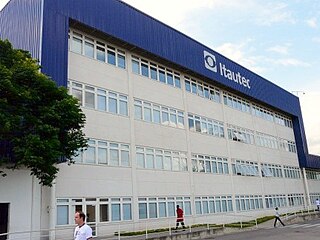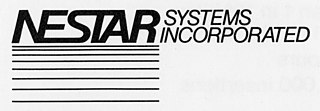
Olivetti S.p.A. is an Italian manufacturer of computers, tablets, smartphones, printers and other such business products as calculators and fax machines. Headquartered in Ivrea, in the Metropolitan City of Turin, the company has been part of the TIM Group since 2003. One of the first commercial programmable desktop calculators, the Programma 101, was produced by Olivetti in 1964 and was a commercial success.

Videx, Inc., is a Corvallis, Oregon manufacturer of computer hardware such as access control products and data collection terminals. It was founded in 1979 by Paul Davis.
Ohio Scientific, Inc., was a privately owned American computer company based in Ohio that built and marketed computer systems, expansions, and software from 1975 to 1986. Their best-known products were the Challenger series of microcomputers and Superboard single-board computers. The company was the first to market microcomputers with hard disk drives in 1977.

Itautec is a Brazilian electronics company founded in 1979. It is part of Itaúsa, a Brazilian business group.

The history of the personal computer as a mass-market consumer electronic device began with the microcomputer revolution of the 1970s. A personal computer is one intended for interactive individual use, as opposed to a mainframe computer where the end user's requests are filtered through operating staff, or a time-sharing system in which one large processor is shared by many individuals. After the development of the microprocessor, individual personal computers were low enough in cost that they eventually became affordable consumer goods. Early personal computers – generally called microcomputers – were sold often in electronic kit form and in limited numbers, and were of interest mostly to hobbyists and technicians.
Realistic Controls Corporation (NCC), later Nylac Computer Corporation and Archives, Inc., was an American computer company based in Davenport, Iowa, founded in 1974.

Harry T. Garland is a scientist, engineer, author, and entrepreneur who co-founded Cromemco Inc., one of the earliest and most successful microcomputer companies. He received the B.A. degree in mathematics from Kalamazoo College, and the Ph.D. degree in biophysics from Stanford University. Dr. Garland has been recognized as one of the most important innovators in the development of personal computers in Silicon Valley.
Systime Computers Ltd was a British computer manufacturer and systems integrator of the 1970s and 1980s. During the late 1970s and early 1980s, Systime become the second largest British manufacturer of computers, specializing in the minicomputer market.

Nestar Systems, Inc., was an early independent manufacturer of pre-internet local area networks for personal computers from 1978 to 1986 and was considered "a pioneer in the industry". It produced three major generations of products:
Smoke Signal Broadcasting, Inc. (SSB), later known as Smoke Signal, was an American computer company founded in 1976 by Frederic Jerome "Ric" Hammond of Hollywood, California. The company earned its reputation by offering expansions for the Southwest Technical Products (SWTPC) 6800 microcomputer. It later manufactured its own line of computers, called the Chieftain. Though it remains little-known, Smoke Signal was an early and important manufacturer of multi-user computer systems.

The Keyboard Company, Inc., was an American electronics company based in Garden Grove, California. It was contracted by Apple Computer to produce the keyboards of their microcomputers in the late 1970s and early 1980s. The company also produced a number of peripherals separately for Apple's systems. Apple acquired the company in 1982 and renamed it the Apple Accessory Products Division (APD).
Amdek Corporation was an American computer peripheral and system manufacturer active from 1981 to the mid-1990s. The company was renowned for their standalone computer monitors compatible with a wide array of systems from the early microcomputer era to the personal computer age. According to PC World in 1994, "Amdek was once the name in PC monitors. Chances are the monochrome monitors most of us used once carried the Amdek label." In the early 1980s, the company was majority owned by the Roland Corporation's Taiwanese subsidiary; in 1986, after a brief period of independence, the company was acquired by Wyse Technology, a maker of computer terminals, who continued the Amdek brand into at least 1995.
Midwest Scientific Instruments, Inc. (MSI), often shortened to Midwest Scientific, was an American computer company founded in Olathe, Kansas, in the early 1970s. Charles C. Childress, a doctorate of biochemistry, founded the company as a way to market his data acquisition and processing interfaces based on programmable calculators for medical, scientific, and industrial uses. After an after-market floppy drive system for the SWTPC 6800 proved a hot-seller for Midwest in 1976, the company began products for general-purpose computers like the SWTPC. In 1977, they released their own microcomputer, the MSI 6800—a clone of the SWTPC 6800. Their sales tripled that year and prompted expansion in the Kansas City area. It survived into the mid-1980s before going defunct and having its remaining assets auctioned off.
Zeda Computers International Limited, trading as Zeda Computer Systems, was an American computer company based in Provo, Utah, and with overseas office in Nottingham. Founded in 1974, their best-selling computer was the Zeda 580, a Zilog Z80-based all-in-one microcomputer.
Terak Corporation was an American computer company based in Scottsdale, Arizona. The company was among the first to market graphical workstations, with their most successful being the Terak 8510/a in 1977. After going public in 1983, the company was acquired by Sanders Associates, who placed it under their CalComp division.
Teleram Communications Corporation was a pioneering American computer company that manufactured the first commercially successful portable computers in the mid-1970s. Based in Mamaroneck, New York, Teleram was founded by Charles J. Satuloff in 1973.

Billings Computer Corporation was a publicly traded computer company and fully owned subsidiary of Billings Energy Corporation, a defunct American energy company based in Provo, Utah, that specialized in hydrogen fuel. Billings Computer was active between 1977 and 1985 and released several minicomputers and microcomputer systems.
Logical Machine Corporation (LOMAC), originally John Peers and Company, later Logical Business Machines, Inc., was a computer company active from the mid-1970s to the 1980s.
Northwest Microcomputer Systems, Inc. (NMS), was a short-lived, privately owned American computer company active from 1977 to the early 1980s and based out of Oregon. The company was co-founded by several computer engineers and investors, including Randy Bush.

Computer Transceiver Systems, Inc. (CTSI) was an American computer company active from 1968 to 1998. It manufactured a wide range of portable data terminals, portable computers, and printers for microcomputers under the Execuport name. It was originally based in Upper Saddle River, New Jersey, soon relocating to Paramus, New Jersey, where it spent most of its independent existence.









